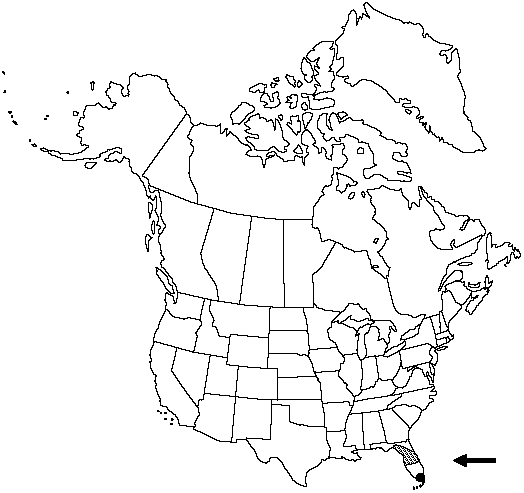FNA>Volume Importer |
FNA>Volume Importer |
| Line 25: |
Line 25: |
| | }}<!-- | | }}<!-- |
| | | | |
| − | --><span class="statement" id="st-d0_s0" data-properties="root reproduction"><b>Roots </b>proliferous.</span> <span class="statement" id="st-d0_s1" data-properties="stem orientation;stem architecture"><b>Stems </b>erect, unbranched;</span> <span class="statement" id="st-d0_s2" data-properties="scale coloration;scale shape;scale shape;scale shape;scale length;scale width;margin architecture or shape">scales blackish throughout, linear to narrowly triangular, 0.9–1.3 × 0.1–0.4 mm, margins entire.</span> <span class="statement" id="st-d0_s3" data-properties="leaf architecture"><b>Leaves </b>monomorphic.</span> <span class="statement" id="st-d0_s4" data-properties="petiole coloration;petiole atypical some measurement;petiole some measurement;petiole length"><b>Petiole </b>brownish black, 0.5–3 (–5) cm, 1/9–1/7 length of blade;</span> <span class="statement" id="st-d0_s5" data-properties="scale coloration;scale shape">indument of blackish, linear-lanceolate scales at base.</span> <span class="statement" id="st-d0_s6" data-properties="blade shape;blade architecture or shape;blade atypical length;blade length;blade atypical width;blade width;blade width;blade pubescence"><b>Blade </b>narrowly lanceolate, 2–3-pinnate, (4–) 10–20 (–) 30 × 1–3 (–5) cm, thin, glabrous;</span> <span class="statement" id="st-d0_s7" data-properties="base shape">base tapered somewhat;</span> <span class="statement" id="st-d0_s8" data-properties="apex architecture">apex formed by gradual reduction, not rooting.</span> <span class="statement" id="st-d0_s9" data-properties="rachis coloration;rachis reflectance;rachis pubescence"><b>Rachis </b>blackish brown, dull, essentially glabrous.</span> <span class="statement" id="st-d0_s10" data-properties="pinna shape;pair atypical count;pair atypical count;pair count"><b>Pinnae </b>in (8–) 12–16 (–22) pairs, oblong;</span> <span class="statement" id="st-d0_s11" data-properties="medial pinna length;medial pinna width">medial pinnae 0.5–2.5 × 3–10 mm;</span> <span class="statement" id="st-d0_s12" data-properties="base shape">base cuneate;</span> <span class="statement" id="st-d0_s13" data-properties="apex shape">apex obtuse.</span> <span class="statement" id="st-d0_s14" data-properties="segment count"><b>Pinnules </b>of 1–5 segments;</span> <span class="statement" id="st-d0_s15" data-properties="segment shape;segment length;segment width;segment architecture or shape">segments oblanceolate, 2–3 × 1–2 mm, entire;</span> <span class="statement" id="st-d0_s16" data-properties="apex shape">apex mostly round.</span> <span class="statement" id="st-d0_s17" data-properties="vein fusion;vein prominence;vein count"><b>Veins </b>free, evident, 1 per segment.</span> <span class="statement" id="st-d0_s18" data-properties="sorus count"><b>Sori </b>1 per segment.</span> <span class="statement" id="st-d0_s19" data-properties=""><b>Spores </b>64 per sporangium.</span> <span class="statement" id="st-d0_s20" data-properties="spore count;2n chromosome count">2n = 144.</span><!-- | + | --><span class="statement" id="st-undefined" data-properties=""><b>Roots </b>proliferous. <b>Stems</b> erect, unbranched; scales blackish throughout, linear to narrowly triangular, 0.9–1.3 × 0.1–0.4 mm, margins entire. <b>Leaves</b> monomorphic. <b>Petiole</b> brownish black, 0.5–3(–5) cm, 1/9–1/7 length of blade; indument of blackish, linear-lanceolate scales at base. <b>Blade</b> narrowly lanceolate, 2–3-pinnate, (4–)10–20(–)30 × 1–3(–5) cm, thin, glabrous; base tapered somewhat; apex formed by gradual reduction, not rooting. <b>Rachis</b> blackish brown, dull, essentially glabrous. <b>Pinnae</b> in (8–)12–16(–22) pairs, oblong; medial pinnae 0.5–2.5 × 3–10 mm; base cuneate; apex obtuse. <b>Pinnules</b> of 1–5 segments; segments oblanceolate, 2–3 × 1–2 mm, entire; apex mostly round. <b>Veins</b> free, evident, 1 per segment. <b>Sori</b> 1 per segment. <b>Spores</b> 64 per sporangium. <b>2n</b> = 144.</span><!-- |
| | | | |
| | -->{{Treatment/Body | | -->{{Treatment/Body |
| Line 55: |
Line 55: |
| | |publication year=1906 | | |publication year=1906 |
| | |special status= | | |special status= |
| − | |source xml=https://jpend@bitbucket.org/aafc-mbb/fna-fine-grained-xml.git/src/287ef3db526bd807d435a3c7423ef2df1e951227/V2/V2_644.xml | + | |source xml=https://jpend@bitbucket.org/aafc-mbb/fna-data-curation.git/src/9216fc802291cd3df363fd52122300479582ede7/coarse_grained_fna_xml/V2/V2_644.xml |
| | |genus=Asplenium | | |genus=Asplenium |
| | |species=Asplenium verecundum | | |species=Asplenium verecundum |
| − | |2n chromosome count=144
| |
| − | |apex architecture=not rooting
| |
| − | |apex shape=round;obtuse
| |
| − | |base shape=cuneate;tapered
| |
| − | |blade architecture or shape=2-3-pinnate
| |
| − | |blade atypical length=4cm;10cm
| |
| − | |blade atypical width=3cm;5cm
| |
| − | |blade length=10cm;20[-]30cm
| |
| − | |blade pubescence=glabrous
| |
| − | |blade shape=lanceolate
| |
| − | |blade width=thin;1cm;3cm
| |
| − | |leaf architecture=monomorphic
| |
| − | |margin architecture or shape=entire
| |
| − | |medial pinna length=0.5mm;2.5mm
| |
| − | |medial pinna width=3mm;10mm
| |
| − | |pair atypical count=16;22
| |
| − | |pair count=12;16
| |
| − | |petiole atypical some measurement=3cm;5cm
| |
| − | |petiole coloration=brownish black
| |
| − | |petiole length=1/9 length of blade;1/7 length of blade
| |
| − | |petiole some measurement=0.5cm;3cm
| |
| − | |pinna shape=oblong
| |
| − | |rachis coloration=blackish brown
| |
| − | |rachis pubescence=glabrous
| |
| − | |rachis reflectance=dull
| |
| − | |root reproduction=proliferous
| |
| − | |scale coloration=blackish;blackish
| |
| − | |scale length=0.9mm;1.3mm
| |
| − | |scale shape=linear-lanceolate;linear;narrowly triangular
| |
| − | |scale width=0.1mm;0.4mm
| |
| − | |segment architecture or shape=entire
| |
| − | |segment count=1;5
| |
| − | |segment length=2mm;3mm
| |
| − | |segment shape=oblanceolate
| |
| − | |segment width=1mm;2mm
| |
| − | |sorus count=1
| |
| − | |spore count=64
| |
| − | |stem architecture=unbranched
| |
| − | |stem orientation=erect
| |
| − | |vein count=1
| |
| − | |vein fusion=free
| |
| − | |vein prominence=evident
| |
| | }}<!-- | | }}<!-- |
| | | | |
| | -->[[Category:Treatment]][[Category:Asplenium]] | | -->[[Category:Treatment]][[Category:Asplenium]] |
Roots proliferous. Stems erect, unbranched; scales blackish throughout, linear to narrowly triangular, 0.9–1.3 × 0.1–0.4 mm, margins entire. Leaves monomorphic. Petiole brownish black, 0.5–3(–5) cm, 1/9–1/7 length of blade; indument of blackish, linear-lanceolate scales at base. Blade narrowly lanceolate, 2–3-pinnate, (4–)10–20(–)30 × 1–3(–5) cm, thin, glabrous; base tapered somewhat; apex formed by gradual reduction, not rooting. Rachis blackish brown, dull, essentially glabrous. Pinnae in (8–)12–16(–22) pairs, oblong; medial pinnae 0.5–2.5 × 3–10 mm; base cuneate; apex obtuse. Pinnules of 1–5 segments; segments oblanceolate, 2–3 × 1–2 mm, entire; apex mostly round. Veins free, evident, 1 per segment. Sori 1 per segment. Spores 64 per sporangium. 2n = 144.
Habitat: Limestone outcrops in grottoes, on cliffs, and on boulders in shaded woods
Elevation: 0–50 m
Discussion
This delicate spleenwort, Asplenium verecundum, occurs in both southern and central peninsular Florida where it is very local. Sterile hybrids are known to result from crossing with A. trichomanes-dentatum (A. × biscayneanum) and A. abscissum (A. × curtissii).
Asplenium verecundum may be a variety or cytotype of the similar A. myriophyllum (Swartz) C. Presl of the West Indies (D. B. Lellinger 1985).
Selected References
None.

